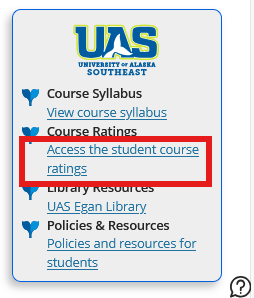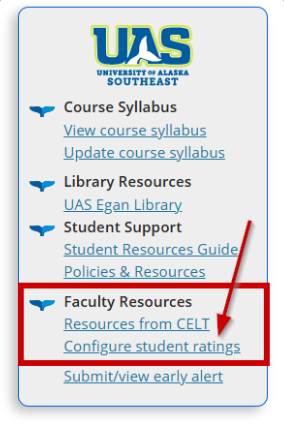UAS Course Ratings: Student Evaluations of your course
- Assessment
Last modified: November 17, 2025
UAS Course Ratings are student evaluations that provide feedback on your course. You will need these when you compile your P&T packet.
Understanding and Using UAS Student Ratings
Student ratings are a tool UAS has for anonymous evaluations of courses by students at the end of the semester. Numerical data should be interpreted with care, especially in small classes. The written comments can provide context and suggestions for improvement.Accessing the Student Ratings Tool
You can find the student ratings system in Blackboard Ultra under the sidebar link “UAS Student Ratings” or listed under “Tools.”- For students: Evaluations become available near the end of the semester, during a designated window.
- Students will receieve and email reminder about ratings with a link, and they can access them in the menu under the UAS logo in Blackboard under the ratings link.

- Students will receieve and email reminder about ratings with a link, and they can access them in the menu under the UAS logo in Blackboard under the ratings link.
- For instructors: Before the ratings open, you can edit certain questions as well as the date window to extend the timing.
- Results are accessible after final grades are submitted.

- Results are accessible after final grades are submitted.
**You can also find the full tool to access Student ratings settings under the "books and tools" menu higher up in the right-hand navigation menu.
CELT recommends extending the response window to the longest possible timeframe to encourage higher participation.
Viewing Results
When evaluations close and grades are submitted, you’ll have access to both Word and Excel report formats.- The Word output starts with a blank page—make sure to scroll down to find the content.
- The Excel report includes anonymized individual responses. It’s especially useful if you want to see how comments align with numerical ratings.
Tips for Interpreting the Data
Several faculty members shared strategies that help them make the most of student ratings. Here are some takeaways:Use with caution: In small classes, the numerical ratings can be statistically unreliable. It may help to view the comments for more actionable feedback.
Track over time: Rather than reacting to one semester’s data, track your ratings across multiple terms to identify trends.
DIY dashboards: Some instructors use spreadsheets or R scripts to compile and visualize trends using bar graphs and plots. It is often helpful to look for patterns across semesters rather than reacting to single comments.
Boosting Response Rates and Student Buy-in
Some instructors have developed successful strategies to increase participation and improve the quality of feedback:Midterm Feedback: Sending your own custom survey, anonymous or otherwise, around mid-semester can help you to respond better to students, as well as to set a habit of response to feedback forms. This can be a good time to remind them that there will be an end-of-course survey, and where to find it. Typical questions include:
What is going well?
Is there anything that has been confusing?
Is there anything else I should know?
- Incentives: Offering a small extra credit bonus for everyone if a certain number (e.g. 75%) of students complete the end-of-semester ratings has proven effective in boosting participation. Since the course ratings are anonymous, you cannot offer individual extra credit.
- Close the loop: Sharing how you responded to student suggestions in the past (or to mid-semester feedback) increases student engagement with the formal evaluation process.